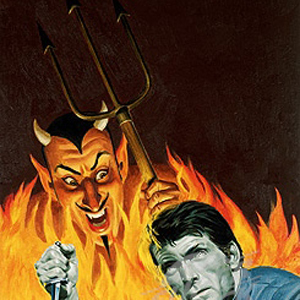
We’ve all heard of the Christian Satan (a.k.a. Lucifer, Beelzebub, etc. yada yada yada I’ve said this before), and thus you may have noticed his appearance throughout culture. You may also have heard that Satan’s design is a composite of pagan gods. Baal is one of those gods, and his role in the birth of the devil is a large and important one.
Let’s first start with Baal himself. While the word Baal (or Ba’al) itself simply means “lord”, and was also used as a title for a number of gods in the Canaanite religion, it is also a common way of referring to Baal Hadad, who for the purpose of this post we’ll refer to simply as Baal. He was a god of storms, thunder, rain, weather, and fertility. Among his notable features includes horns (or a horned headdress) and a thunderbolt, usually three-pronged, the latter of which would later appear as a weapon wielded by gods like Zeus and Indra. Baal was also equated with the Egyptian god Set, who, like Baal, was a strong and virile god of storms, but he was also a god of deserts who was also associated with foreigners and worshipped by Egyptian armies and soldiers, until later myths were he was a god of evil, darkness, and chaos (Egyptians really didn’t like chaos).

Now we move on to Baal in Judaism. While there is no concept of the devil within Judaism, let alone as a being who opposes God, a similar kind of being is found in Ba’al Zebub. In Rabbinical texts, the name Ba’al Zebub (meaning “lord of the flies”) was the Jewish way of mocking the religion of Baal that surrounded them, and its followers, and it may have been a way of referring to Baal as a pile of dung and his followers as flies. They saw Baal as a false god, unworthy of worship. Does that sound familiar? Of course, it’s a lot like the later Christian concept of Satan. The term Ba’al Zebub is the source of the name Beelzebub, and may have come from a Philistine deity named Baal Zebul.
In Christianity, we have Satan (who the Jewish Beelzebub is now synonymous with), who is most commonly shown as a horned male figure with a trident or pitchfork, along with other features like wings and a tail. The horned devil with a trident actually calls back to the god Baal with his horns and thunderbolt. It should be noted that Baal, or more or less the religion of Baal, was the biggest rival to the Jewish and Christian religions, so it seemed only natural for them to vilify him, and for the Christians to co-opt him into the design of the devil. Images of Baphomet may also be similar, being a horned entity holding objects.

So there you have it, Satan’s primary origins lie in the Canaanite god Baal, and in the Jewish (and later Christian) transformation of him (Beelzebub). There’s the traditional devil in Christianity, then before that a mockery/vilification of Baal in Judaism, and before that, Baal in the pre-Christian world. Baal does seem to me like the archetypal (male) pagan god, and that would probably make sense with regards to his vilification.
I personally equated Baal with YHWH rather than Satan, as El was the Ugaritic equivalent and most of their shared imagery and epithets include ‘lightning language’ similar to those used for YHWH. There is also the fact that Elohim is a derivative of El.
I would have also been interested in further exploration of the characters of the serpent and the adversary (in Genesis and Job respectively, so Hebrew Bible and not New Testament) as many Christians file them under the character of Satan.
I thought El was YHWH.
I have a strong feeling that Baal Hamun is indeed the Baphoment.
Partly because all other religions vilified Baal Hamun, including the Romans – vilifying Carthage as evil child killers.
Baal Hammon (I assume that’s what you meant by “Baal Hamun”) would have been just another form of the Ba’al deity within Levantine paganism, so it doesn’t make sense from a historical perspective to say that he would have been vilified by all other religions. He probably would have been vilified by the Romans, given that Carthage was indeed the enemy at the time, but other than that I’m not seeing it.
And there is nothing to suggest that Ba’al Hammon is the Baphomet. Really there are two “Baphomets” as it were: the Baphomet worshipped by the Knights Templar, whose name comes from a vilification of the Islamic prophet Muhammad, and the Baphomet of Eliphas Levi, which is very explicitly based on Banebdjedet as well as Pan, Ba’al Hammon never really entered the picture. It’s more likely that Ba’al Hammon was the inspiration for Moloch, a fictional deity/demon who doesn’t appear anywhere outside of the Bible and was not counted among the Levantine pantheon. Both Ba’al Hammon and Moloch are associated with similar accounts of ritualistic child sacrifice, whether real or imagined.